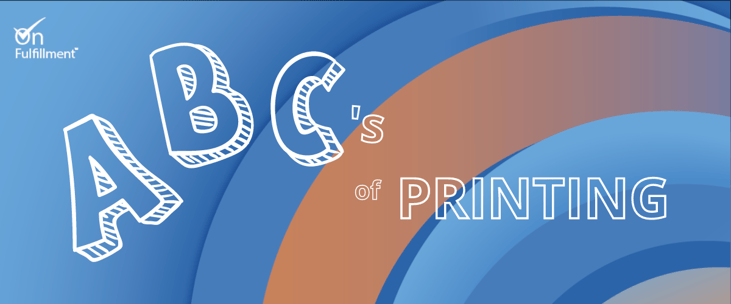If you’ve worked with commercial printers, you know that sometimes they start speaking a whole different language. We feel your pain!
Chances are, you don’t have time to invest in a copy of the Pocket Pal, produced by International Paper and generally regarded as the “industry Bible” of graphic arts terminology. You don’t really need to. A few printing 101 lessons will bring you up to speed in no time.
To help marketers everywhere, we’ve put together a handy list of printing terms that have one nifty thing in common – they’re all acronyms! Enjoy this alphabet soup of printing terms!

AR codes
The AR stands for Augmented Reality (AR), a fascinating, new-ish technology that can place a virtual image in a live experience. You point your computer or smartphone camera at a code-embedded, high-contrast image such as one printed on a page that triggers a virtual holographic-type image. The image comes to life right before your eyes. It can include sound, video, graphics, and GPS data. (Read about IKEA’s AR catalog here….incredible!)
CMYK
CMYK stands for Cyan, Magenta, Yellow and blacK. This acronym is perhaps the best known of all. It refers to the 4 process colors used in 4-color printing. C is for Cyan (blue); M is for Magenta (red); Y is for Yellow; and K is for blacK. Printers will talk about 4-color printing, full-color printing, or even process printing. They all mean the same thing.
FPO (For Position Only)
In digital imaging, “FPO” indicates that a low-resolution image has been positioned in a document and will be replaced later with a higher resolution version of the same image.
JPEG
The Joint Photographic Experts Group was formed to create a standard for color and gray-scale image compression. JPEG describes a variety of algorithms (rules), each of which is targeted for a specific type of image application. JPEG is the default format for most digital cameras.
KO’s or reverses
This acronym describes type or imagery that reverses out (‘Knocks Out’) of a surrounding area that’s printed. Two things to be mindful of: 1) fine type or line art can be difficult to reverse out of a solid, and 2) make sure the ink used when you’re doing a KO is dark enough to provide sufficient contrast.
M
M is an abbreviation for “mega” that’s commonly used to mean one million. In printing, it’s also the abbreviation for a quantity of 1,000.
OCR
OCR stands for Optical Character Recognition. It’s an electronic means of scanning (reading) copy and converting the scanned image to an electronic equivalent. It’s the ability to “read” printed text (characters) and convert it to digitized files that can be saved and edited as a text file.
PDF stands for Portable Document Format. By now, everyone’s pretty familiar with PDFs. Adobe’s PDF is a universal electronic file format, modeled after the PostScript language. It’s device- and resolution- independent. PDF documents can be viewed, navigated, and printed from any computer to almost any printer regardless of the fonts or software programs used to create the original. Learn more about print-ready PDFs here.
PMS
PMS stands for Pantone Matching System®, the standard ink color system used by commercial printers. There are thousands of PMS colors to choose from. You might have a PMS swatch book on hand already. It’s a fantastic and critical tool for print customers. Check out www.pantone.com for all sorts of interesting color information. Pantone does color forecasts, a neat color blog, and color trends. Guess what the color of the year is? Anyone? Marsala.
pURLS
pURLS stands for personalized URLs. This technology lets you create a separate URL for each person you're targeting. A smart use of pURLs is on a marketing campaign when you want to engage direct mail recipients. Use pURLs to get folks back to their private little web page, where they can enter key data, participate in a contest, or otherwise tell you more about themselves in ways that will help you serve them better.
QR Code
A “Quick Response” code is a 2D barcode that’s decoded using a smartphone camera and Internet connectivity. Activating a QR code will lead viewers to a website, special landing page, or other digital destination, where they can access additional information and images. It’s a smart way to provide relevant and engaging interactivity in a marketing campaign.
RGB
(Red, Green, and Blue are the three primary additive colors used in display devices and scanners. They’re commonly used to refer to the color space, mixing system, or monitor in color computer graphics.
VDP
VDP stands for Variable Data Printing. Also known as 1:1 printing and personalized printing, it’s a digital print technology that lets marketers produce personal print materials using an uploaded database. Each printed image can contain different images, colors and content. Talk about targeted marketing!
We hope this short list of print industry acronyms makes working with your favorite printer easier and more enjoyable. Toss a few around at your next party and see who takes notice – they might be printers, paper professionals, graphic designers, print buyers or fellow marketers.

